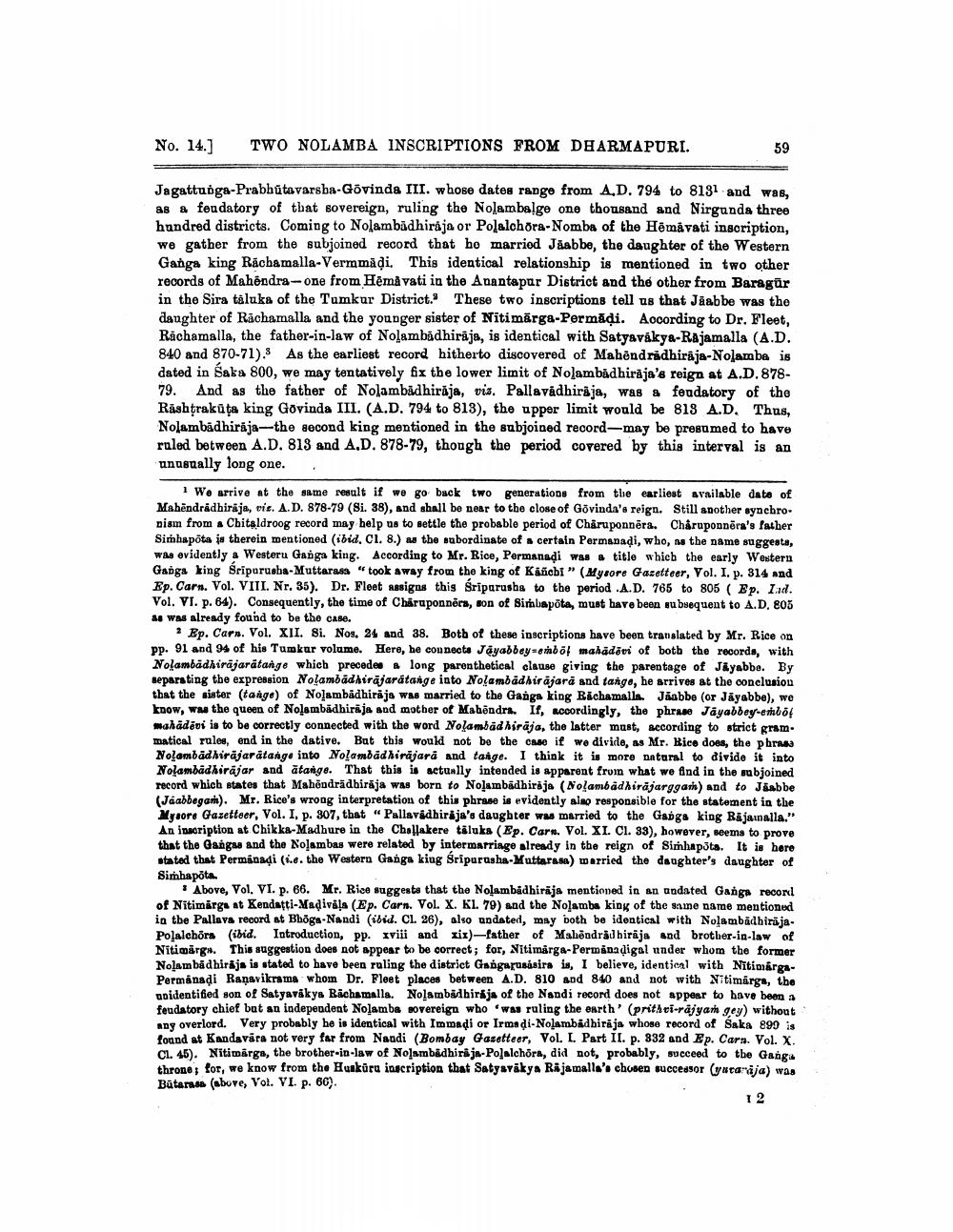________________
No. 14.]
TWO NOLAMBA INSCRIPTIONS FROM DHARMAPURI.
59
Jagattuðga-Prabhutavarsba-Govinda III. whose dates range from A.D. 794 to 8131 and was, as a fendatory of that sovereign, ruling the Nolambalge one thousand and Nirgunda three hundred districts. Coming to Nolambadhiraja or Polalchora-Nomba of the Hēmåvati inscription, we gather from the subjoined record that he marriod Jäabbe, the daughter of the Western Ganga king Riobamalla-Vermmadi. This identical relationship is mentioned in two other records of Mahendra-one from Hemåvati in the Anantapur District and the other from Baragür in the Sira tåluka of the Tumkur District. These two inscriptions tell us that Jāabbe was the daughter of Rachamalla and the younger sister of Nitimärga-Permāļi. According to Dr. Fleet, Rachamalla, the father-in-law of Nolambidhiraja, is identical with Satyavákya-Rajamalla (A.D. 840 and 870-71). As the earliest record hitherto discovered of Mahendradbiraja-Nolamba is dated in Saba 800, we may tentatively fix the lower limit of Nolambadhiraja's reign at A.D.87879. And as the father of Nolambadhiraja, viz. Pallavádbirija, was a feudatory of the Rashtrakūta king Govinda III. (A.D. 794 to 813), the upper limit would be 818 A.D. Thus, Nolambadhiraja-the second king mentioned in the subjoined record-may be presumed to have ruled betwoen A.D. 813 and A.D. 878-79, thongh the period covered by this interval is an unusually long one.
I Wo arrive at the same result if we go back two generations from the earliest available date of Mahendradhirijs, vis. A.D. 878-79 (Si. 38), and shall be near to the close of Govinda's reign. Still another synchro. nism from a Chitaldroog record may help us to settle the probable period of Chåruponnēra. Chåruponnēra's father Simhapota is therein mentioned (ibid. CI. 8.) as the subordinate of certain Permanadi, who, as the name suggesta, was evidently a Westeru Ganga king. According to Mr. Rice, Permanadi was a title which the early Western Ganga king Sriparusba-Muttarass "took away from the king of Káñcbi" (Mysore Gazetteer, Vol. I. p. 314 and Ep. Carn. Vol. VIII. Nr. 35). Dr. Floet assigns this Sriparushs to the period .A.D. 765 to 805 ( Ep. Ind. Vol. VI. p. 64). Consequently, the time of Chiroponners, son of Simbapota, must have been subsequent to A.D. 805 at was already found to be the case.
Ep. Cars, Vol. XII. Si. Nos, 24 and 38. Both of these inscriptions have been translated by Mr. Rice on pp. 91 and 94 of his Tumkur volume. Here, he cou necta Jayabbey-ohb of mahadavi of both the records, with Nolambadhirajaratange which precedee #long parenthetical clause giving the parentage of Jiyabbe. By separating the expression Nolambadairājarátange into Nolambadhirajara and tange, be arrives at the conclusion that the sister (tange) of Nolambadhiraja was married to the Ganga king Bachamalls. Jáabbe (or Jayabbe), we know, was the queen of Nolambadhiraja sad mother of Mahendra. If, accordingly, the phrase Jayabbey-enabol mahadevi is to be correctly connected with the word Nolambadhiraja, the latter must, according to strict gram. matical rules, end in the dative. But this would not be the case if we divide, as Mr. Bice does, the phrasa Nolambadhirajaratange into Nolambadhirajara and tange. I think it is more natural to divide it into Nolambadhirajar and atange. That this is actually intended is apparent from what we find in the subjoined record which states that Mahondrädbiraja was born to Nolambadhirajo (Nolambadhirajarggar) and to Jiabbe (Jáabbegan). Mr. Rice's wrong interpretation of this phrase is evidently also responsible for the statement in the Mysore Gazettoer, Vol. I. p. 307, that "Pallavidhiraja's daughter was married to the Gaöga king Räjaunalla." An inscription at Chikka-Madhure in the Challakere tiluks (Ep. Cars. Vol. XI. Cl. 33), however, seems to prove that the Gangas and the Kolambas were related by intermarriage already in the reign of Simhapita. It is here stated that Permanadi (i.e. the Western Ganga king Sripurasha-Muttaras) married the daughter's daughter of Simhapota
* Above, Vol. VI. p. 66. Mr. Rise suggests that the Nolambadhiraja mentioned in an undated Gangs recon of Nitimirga at Kendatti-Madivals (Ep. Cars. Vol. X. KL. 79) and the Nolamba king of the same name mentioned in tbe Pallava record at Bhoga-Nandi (ind. CL. 26), also updated, may both be identical with Nolambadhirija. Polalchors (ibid. Introduction, pp. xvili and ir-father of Malondradhiraja and brother-in-law of Nitimings. This suggestion does not appear to be correct; for, Niti marga-Porminadigal under whom the former Nolambadhirkja is stated to have been ruling the district Gangarusasira is, I believe, identical with NitimargaPermånadi Ranavikrama whom Dr. Floet places between A.D. 810 and 840 and not with Nitimarge, the goidentified son of Satyavákya Bachamalla. Nolambəbirsja of the Nandi record does not appear to have been a feudatory chief but an independent Nolamba sovereign who was ruling the earth' (prithvi-rajyar gey) without Any overlord. Very probably he is identical with Immadi or Irmadi-Nolambadbiraja whose record of Saka 890 is found at Kandavira not very far from Naudi (Bombay Gasetteer, Vol. L Part Il. p. 832 and Ep. Cars. Vol. X. CL. 45). Nitimarga, the brother-in-law of Nolambidhiraja-Polslchora, did not, probably, succeed to the Ganga throne; for, we know from the Hunkuru inscription that Satyavákya Rajamalla's chosen successor (yuranija) was Būtar (above, Vol. VI. p. 66).
12




